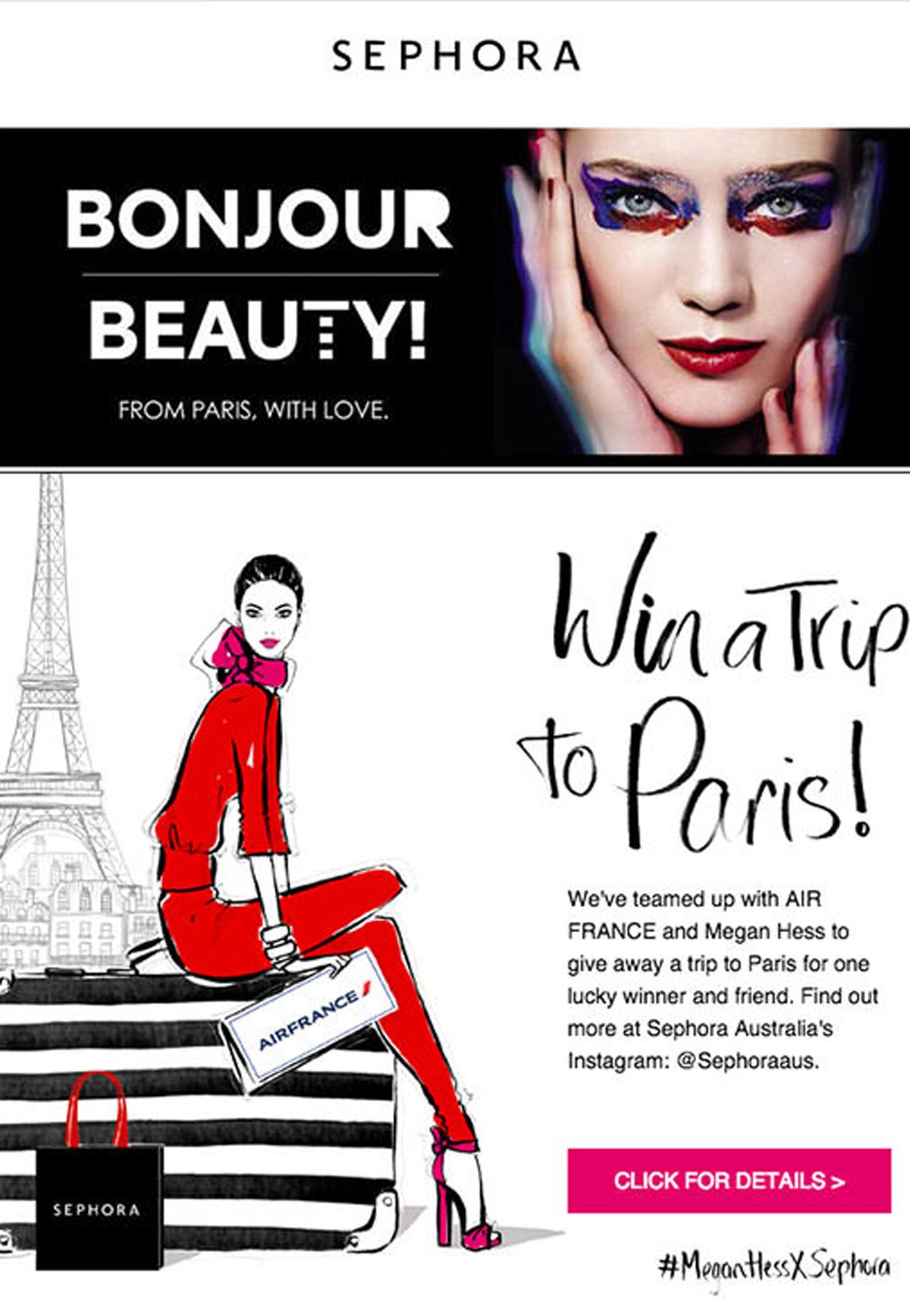Article first published July 2014, updated May 2019
Take a moment to think about your average day. If you’re like many other marketers, a good chunk of your time is probably spent on social media—writing status updates, creating ads, monitoring your mentions, replying to wall posts, etc.
Now take a moment to think about the time you spend on email marketing—growing your list, crafting great email content, and looking at analytics on your list growth and engagement.
Luckily, social media and email don’t have to be an either-or focus. Campaign Monitor has made it simple for brands to incorporate social media into their email strategy. It’s as simple as drag, drop, and customize.
If you find you’re spending a majority of your time on social media—and little to no time on your email list—it could be a potentially tragic mistake that could be costing you sales. Here’s why.
Just the stats: users, open rates, and click-through rates.
With Facebook boasting over 1 billion active users per month and Twitter boasting 255 million, we certainly couldn’t blame you for being persuaded to focus a large portion of your marketing efforts on social media.
But what you don’t see so frequently touted are the statistics on email usage. According to Radicati, the total number of worldwide email accounts was 3.9 billion in 2013, and is projected to be 4.9 billion by 2017.
To put this in perspective for you, there are 3x more email accounts than there are Facebook & Twitter accounts combined.
From a marketing perspective, though, it’s the statistics on reach and engagement that show the real story. Did you know that organic reach on Facebook (i.e., the number of your fans who actually see your posts in their Newsfeed) is only 6%?
On the contrary, open rates for email marketing messages are generally in the 20-30% range,meaning your message is 5x more likely to be seen through email than Facebook.
Similarly, click through rates from email are generally in the 3% range, while click-through rates on Tweets are generally in the 0.5% range. This means you are 6x more likely to get a click-through from email than you are from Twitter.
In order to show this in action, influential marketing blogger Derek Halpern ran a test where he sent his latest blog post to the same number of people via both email and Twitter. Here are the results:
- 300 people clicked through to the article from Twitter
- 4,200 people clicked through to the article from email
But is it easier to build a social media following than an email list?
While it’s clear email has a much better engagement and response rate than social media, you may be thinking that it’s much more difficult to get people to give you permission to email them, as opposed to getting them to become a fan on Facebook or a follower on Twitter.
But that’s not the case.
Always a fan of testing, Derek Halpern did an experiment to see which would be harder: getting people to subscribe to his email list or getting people to follow him on Twitter. You would think people are more likely to click a “follow” button than give up their email address. But you would be mistaken.
In his experiment, he sent 1,000 visitors to his email opt-in page, and 1,000 visitors to his Twitter page. The results? He received almost 500 new email subscribers, making it a conversion rate of almost 50%. While he doesn’t give the exact number of Twitter followers he gained, he did say it was nowhere near 500 new followers, and that the Twitter page underperformed significantly compared to the opt-in page.
In the same piece, he goes on to talk about different ways you can grow your email list successfully and how one of his readers got a 500% increase in the number of people subscribing to their list each day, just by putting opt-in forms in the right places on their website. That’s a significant increase, and, best of all, it was a one-time thing that doesn’t require devoting an hour or two a day to creating, participating in, and monitoring discussions.
How to integrate social media and email
The debate of email marketing vs. social media marketing is a fiery one. Many of you are used to thinking of social media and email marketing as two separate, distinct applications, never to be mixed together. Anyone following this line of thinking, however, is missing out. You’ll find that social media and email marketing mix quite well together.
While email marketing is the undisputed leader, in terms of raw ROI as a marketing channel, cutting out or neglecting social media would be wasteful. In fact, the most successful brands have a more holistic, integrated approach that utilizes both channels.
Part of what makes the holistic approach so successful is that it provides a seamless experience for customers interacting with your brand. Whether they make contact through your company Facebook page, customer support page, or engage with one of your newsletters, you’ll have all the bases covered. Not only that, but customers will enjoy more seamless, reliable, and consistent experiences. All of this helps make your brand stand out in the minds of customers.
The key to getting the highest ROI out of your newsletters is to remember that they’re a strategic tool. That means not spamming your subscribers by overwhelming them with thoughtless, low-impact emails. You’ll do best by focusing on content quality and prioritizing your messages.
While email is a perfect way to reach your customers directly and is best suited for one-on-one type messages, social media is ideal for driving customers as communities. Every time your customers interact together on your social media pages, they breathe life into your brand. Emails can start the conversations that carry over into social media, as customers come to discuss the promotions they’re seeing in your newsletters.
The takeaway is that the paradigm doesn’t have to be email marketing vs. social media marketing. You should pair them together for the most effective strategy.
Why email newsletters are so valuable?
Before delving into the value of email newsletters, remember that social media helps drive customers to sign up for your newsletters. That symbiotic relationship is part of what makes it so important to continuously optimize both email marketing and social media marketing practices.
When it comes to email marketing vs. social media statistics, email marketing, in general, is still the best way to source leads. Furthermore, email is one of the most effective ways to continuously build customer loyalty. The longer a subscriber stays tuned in to your newsletters, the more invested they’ll be in your brand.
As it turns out, your newsletters can feed traffic right back into social media by embedding your page links in the emails. Statistics aside, as long as you do your best in using both channels, you’ll see more traffic driven to your brand.
You can think of it as a cyclical, holistic system, with each part affecting the others. Your newsletters can affect social media traffic, and vice versa. The key is to maximize both and keep the customers flowing in.
With email newsletters, you can send out effective content like this to reach customers.
It all boils down to these three words: return on investment.
The Direct Marketing Association found that email marketing has a ROI of 4300%. Monetate’s Ecommerce Quarterly also showed that email drove more conversions than other marketing channels, including search and social.
| Traffic source | Q1 2012 | Q2 2012 | Q3 2012 | Q4 2012 | Q1 2013 |
| Search | 1.83% | 1.77% | 1.96% | 2.49% | 1.95% |
| Social | 0.49% | 0.60% | 0.73% | 0.88% | 0.71% |
| 3.06% | 3.24% | 3.48% | 3.58% | 3.19% |
It’s not hard to see why, either. According to Facebook, there are 1500 stories they could show on a user’s Newsfeed at any point in time, so it’s not surprising your brand’s posts aren’t making the cut amongst photos of friend’s holidays. And, even if your post did appear, you’re competing for a user’s attention with friends, family, and the latest viral video from BuzzFeed.
On the flipside, when a user logs in to their email account, your email campaign has just as much chance of appearing in the list and getting noticed as everyone else’s. This is more than most brands can say about the reach of their status updates on Facebook and Twitter.
When you see emails from people you know and the companies you love, you’re going to open them and likely click on any links that catch your eye, whether they’re to great pieces of content or special offers. If you think about the number of clicks you’ve made on Facebook ads or Twitter-promoted tweets compared to the clicks you’ve made in email, latter number has likely been much higher.
In conclusion: should I just give up on social media?
We’re not saying you should give up on social media. In fact, social media can be an integral part of growing your email list by using things like the Twitter Lead Generation Cards to get your social media fans and followers on your email list.
What we’re saying is, rather than getting lured in by the hype of social media, stop and consider whether it’s really the best marketing channel to be focusing your limited time and effort on. We think you might find that email is a channel that’s worth a lot more of your time than you think.






